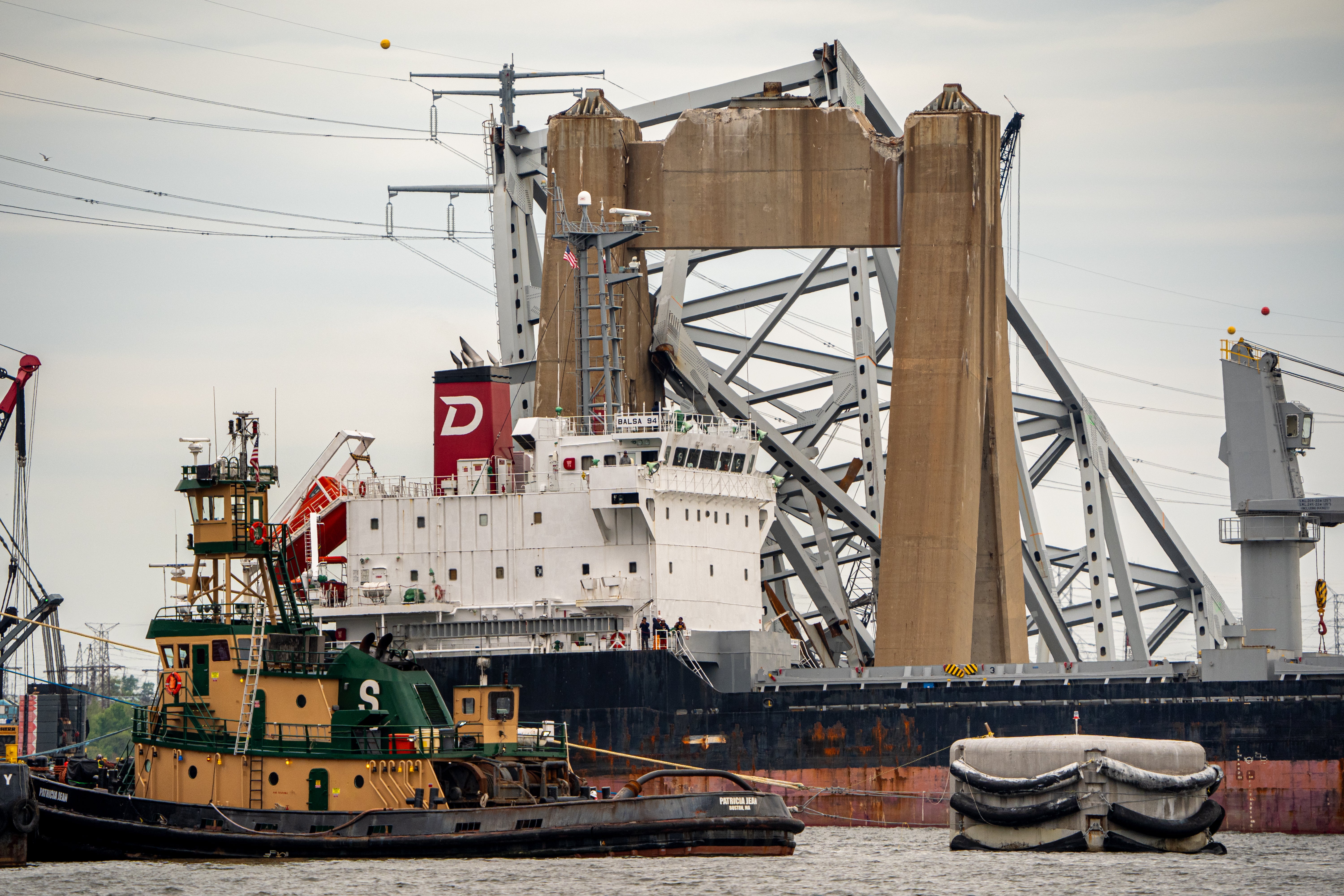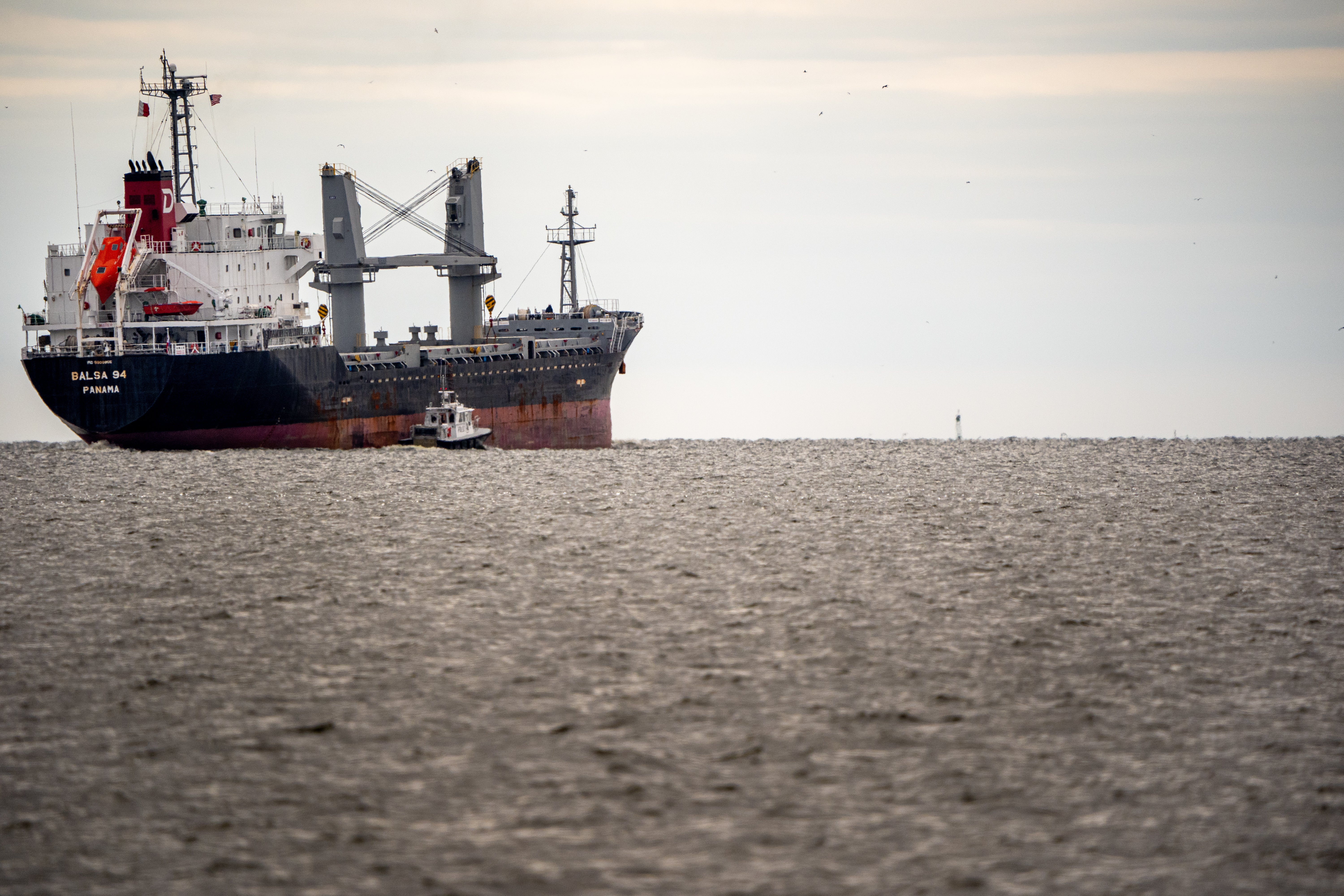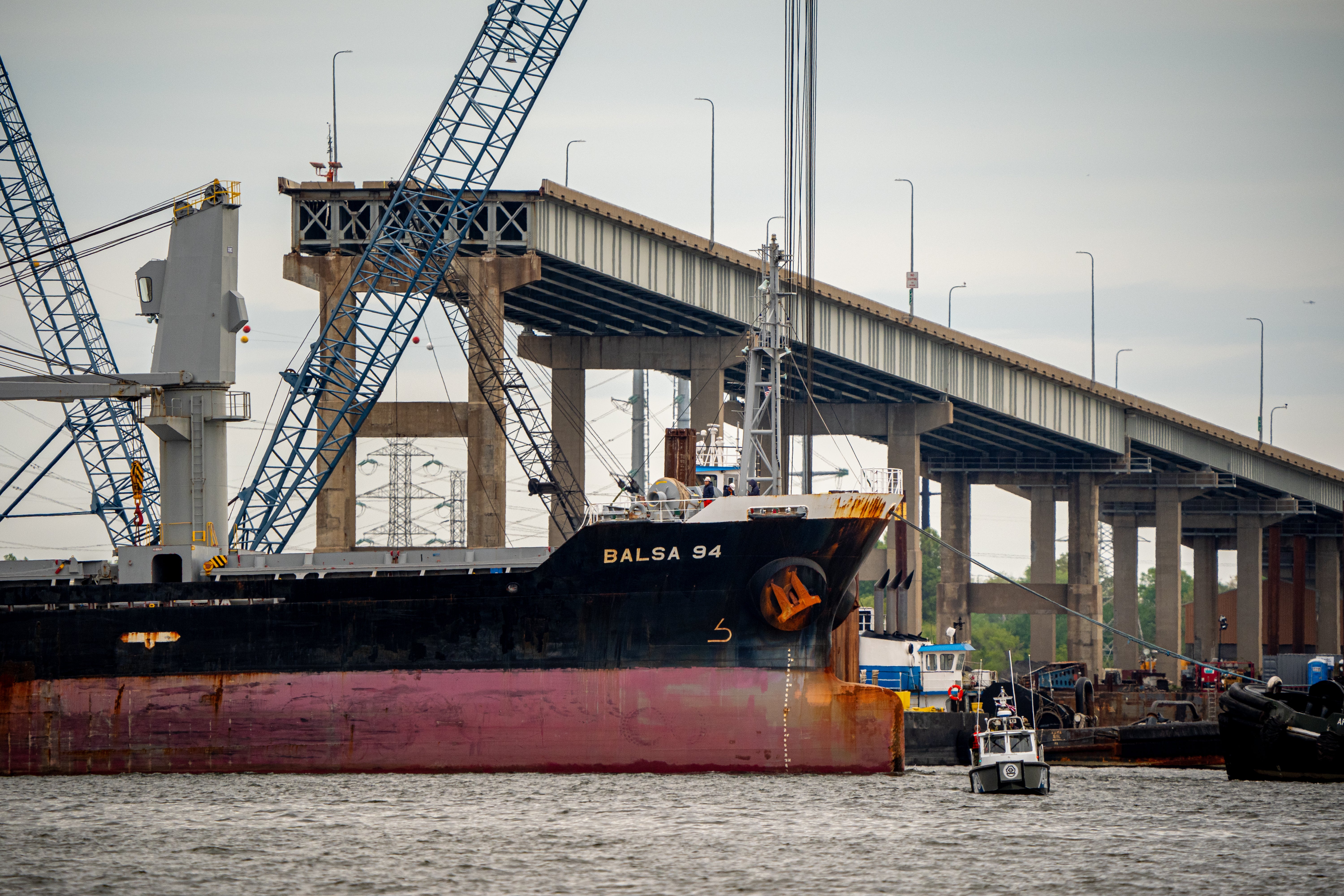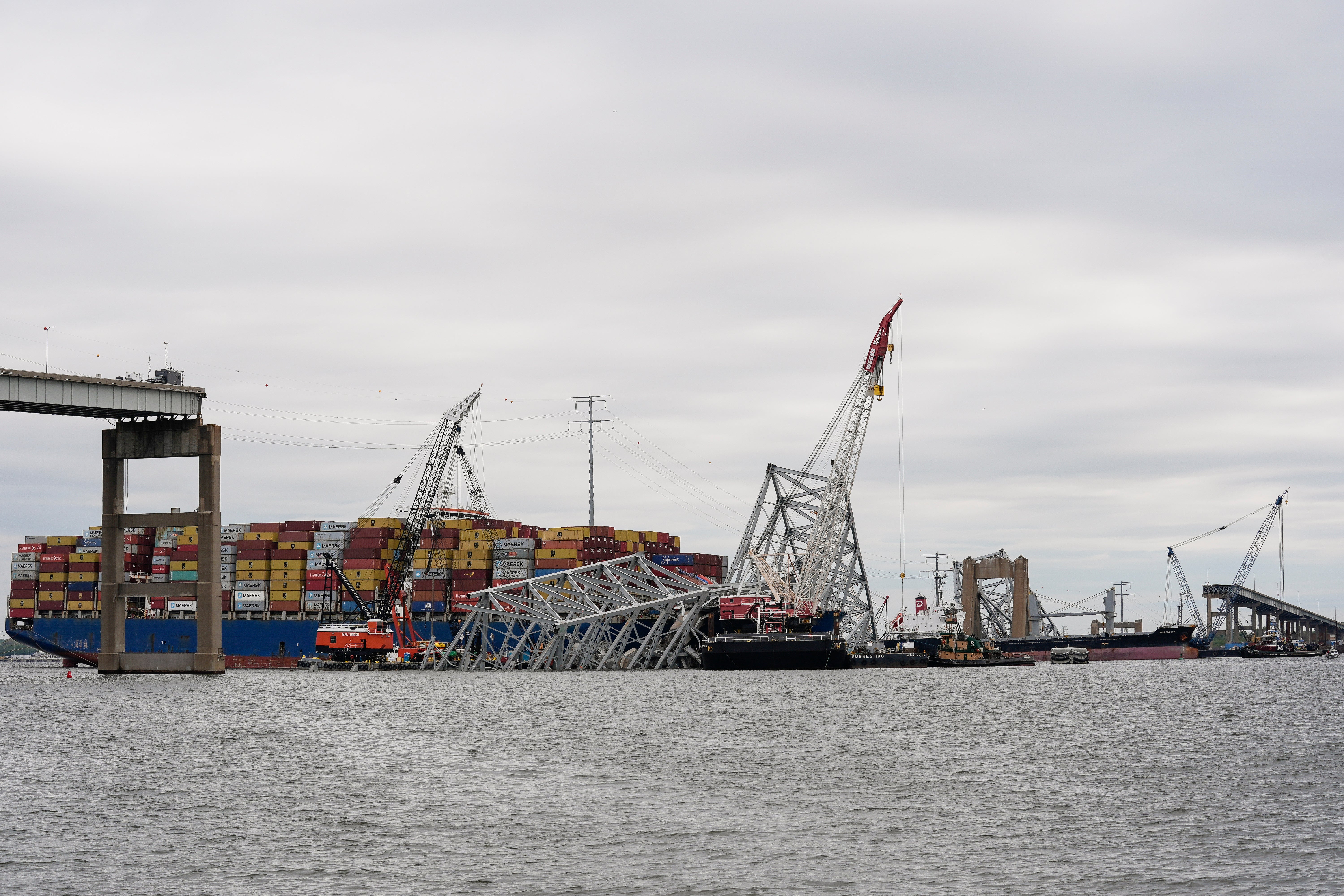After 33 days waiting in the port of Baltimore, Balsa 94 has become the first cargo ship to leave through a temporary channel after the Baltimore bridge collapse
Amelia Neath
The first cargo ship has passed through a newly opened deep-water channel in Baltimore after being stranded in the harbour since the catastrophic bridge collapse brought most marine traffic to a standstill within the port.
The Balsa 94 was left in limbo in Baltimore’s port for a month after another container ship, the Dali, collided with the Francis Scott Key Bridge on 26 March, killing six workers on the bridge and halting marine activity in the city, causing a wider economic impact in Baltimore and on supply chains.
The Balsa 94, a bulk carrier under a Panama flag, sailed on Thursday morning through the new 35ft-deep channel opened by Baltimore officials.
It is a major step taken to get marine traffic flowing after the maritime shipping hub has remained closed to the majority of traffic since the bridge’s collapse.
Heading to St John, Canada, the Balsa 94 is expected to arrive at its intended destination on Monday.

The Balsa 94, a bulk carrier cargo ship, sailing past the Francis Scott Key Bridge wreckage on Thursday (Getty)
The Balsa 94 had been sitting in the port for 33 days and seven hours, according to Vessel Finder, after they arrived on 23 March, mere days before the bridge’s collapse.
The ship was one of five stranded vessels that are expected to make their way through the temporary channel, which will remain open until Monday or Tuesday, then close again until around 10 May, the Port of Baltimore said on X.
This channel is a substantial expansion from the three other temporary channels opened at the port since the collapse, all with various depths – 10ft, 14ft and 20ft – that have allowed commercial vessels to move through.
The temporary port needs to close again for that period of time to enable crews to remove steel from the Dali and refloat the ship, before it is then guided back to the port, officials said.

The Balsa 94 had been sitting in the port for 33 days and seven hours, according to Vessel Finder, after they arrived on 23 March, mere days before the bridge’s collapse.
The ship was one of five stranded vessels that are expected to make their way through the temporary channel, which will remain open until Monday or Tuesday, then close again until around 10 May, the Port of Baltimore said on X.
This channel is a substantial expansion from the three other temporary channels opened at the port since the collapse, all with various depths – 10ft, 14ft and 20ft – that have allowed commercial vessels to move through.
The temporary port needs to close again for that period of time to enable crews to remove steel from the Dali and refloat the ship, before it is then guided back to the port, officials said.

The Balsa 94 sails off toward Canada on Thursday after a month stuck at Baltimore’s port (Getty)
Two tug boats, one in front and one behind, guided the Balsa 94 through the channel, passing between buoys that marked the channel’s boundaries.
Pictures captured the moment the vessel was guided carefully past the remains of the bridge, now tangled in a wreck on the Patapsco River and the ship that crashed into the bridge a month ago.

Two tug boats, one in front and one behind, guided the Balsa 94 through the channel, passing between buoys that marked the channel’s boundaries.
Pictures captured the moment the vessel was guided carefully past the remains of the bridge, now tangled in a wreck on the Patapsco River and the ship that crashed into the bridge a month ago.

The Balsa 94 passing the wreckage on Thursday (Getty)
The Port of Baltimore said they are hoping to reopen the port’s main channel by the end of next month, which will help to restore marine traffic and alleviate economic pressures.
However, crews are still working tirelessly to move the wreckage from the collapse and clear thousands of tonnes of steel and concrete that are blocking other parts of the main channel.
One piece of metal took three days to remove and secure from the wreck site, weighing as much as a 747 jumbo jet, Unified Command said, according to CBS.
Meanwhile, the city of Baltimore filed a lawsuit against the owners of the Dali on Monday, claiming the vessel was “unseaworthy.”
The Dali hit the giant structure in the early hours of the morning after it lost power, with the city claiming that the crew on board the ship knew that the vessel’s power supply was down.

The Port of Baltimore said they are hoping to reopen the port’s main channel by the end of next month, which will help to restore marine traffic and alleviate economic pressures.
However, crews are still working tirelessly to move the wreckage from the collapse and clear thousands of tonnes of steel and concrete that are blocking other parts of the main channel.
One piece of metal took three days to remove and secure from the wreck site, weighing as much as a 747 jumbo jet, Unified Command said, according to CBS.
Meanwhile, the city of Baltimore filed a lawsuit against the owners of the Dali on Monday, claiming the vessel was “unseaworthy.”
The Dali hit the giant structure in the early hours of the morning after it lost power, with the city claiming that the crew on board the ship knew that the vessel’s power supply was down.

The Balsa 94 travelled through a temporary 35-foot-deep channel (AP)
The lawsuit did not include a specific monetary amount sought after, but the lawsuit states that the officials are seeking damages relating to the cost of replacing the bridge, clearing the Patapsco River, increased road traffic and management, and loss of taxes, among other expenses.
The filing came after the Dali’s owners and management filed a petition in the US District Court District of Maryland Northern Division seeking to limit their legal liability to $43.1m.
They cited a Titanic-era law that allows ship owners to limit their liability for certain claims to the value of the vessel and its cargo at the end of its journey.
While the legal action is ongoing, both the FBI and the National Transportation Safety Board are conducting an investigation into what caused the ship to lose power and collide with the bridge.
The lawsuit did not include a specific monetary amount sought after, but the lawsuit states that the officials are seeking damages relating to the cost of replacing the bridge, clearing the Patapsco River, increased road traffic and management, and loss of taxes, among other expenses.
The filing came after the Dali’s owners and management filed a petition in the US District Court District of Maryland Northern Division seeking to limit their legal liability to $43.1m.
They cited a Titanic-era law that allows ship owners to limit their liability for certain claims to the value of the vessel and its cargo at the end of its journey.
While the legal action is ongoing, both the FBI and the National Transportation Safety Board are conducting an investigation into what caused the ship to lose power and collide with the bridge.
No comments:
Post a Comment